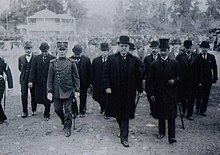Joaquín Samuel de Anchorena
Joaquín Samuel de Anchorena | |
|---|---|
 | |
| 20th Mayor of Buenos Aires | |
| In office October 21, 1910 – October 24, 1914 | |
| President | Roque Sáenz Peña (1910 - 1914) Victorino de la Plaza (1914) |
| Vice President | Victorino de la Plaza (1910 - 1914) |
| Preceded by | Manuel J. Güiraldes |
| Succeeded by | Enrique Palacio |
| Constituency | Buenos Aires |
| Parliamentary Representative, Argentina | |
| In office May 11, 1908 – October 20, 1910 | |
| Constituency | Federal District of Buenos Aires |
| Personal details | |
| Born | August 20, 1876 Buenos Aires, Argentina |
| Died | July 19, 1961 Buenos Aires, Argentina |
| Spouse(s) | Sara Justa Madero Arteaga María Enriqueta Salas Martínez |
| Children | Tomás Joaquín de Anchorena Sara Josefina de Anchorena Esteban Joaquín de Anchorena Carlos Joaquín Anchorena Miguel Joaquín de Anchorena Alejandro Joaquín Anchorena María Enriqueta Anchorena |
| Alma mater | The University of Buenos Aires |
| Occupation | Lawyer |
Joaquín Samuel de Anchorena (1876–1961) was an Argentine lawyer and politician, noted for being mayor of Buenos Aires between 1910 and 1914.
Personal life
Anchorena became a lawyer in 1898, after studying in the Faculty of Law and Social Sciences at the University of Buenos Aires. He was a lover of rural activities, and in his youth was dedicated to keeping the La Merced Ranch, which belonged to his mother. In 1900 he married Sara Madero, who bore him three children. She died in 1911, and five years later Anchorena married his second wife, Henrietta Maria Salas. He had three other children with his second wife.
Political life
He was elected national deputy for the City of Buenos Aires in 1908. When Dr. Roque Saenz Pena assumed the Presidency of la Nación in 1910, Anchorena was recommended by the Minister of Public Works, Ezequiel Ramos Mexia, to fill the Municipality of that city. He was later appointed by the President to that office.
During his tenure he gave contracted the engineers Carlos Thays and Benito Carrasco, for the beautification of the Tres de Febrero Park, inaugurating it as the Rosedal. He also opened the first underground tramway done by the Anglo-Argentine Tramways Company (now Underground Line A), on December 1, 1913. Work was carried out on the expansion of the City Hall towards the Rivadavia street, which was extended throughout his term. His term ended in 1914.
Accomplishments
Anchorena also served as Comptroller in the province of Entre Rios. He was part of the Fiscal Oilfields Directory and President of the Columbus Theater.[1]
He served as President of the Argentine Rural Society between 1916 and 1922. In 1917 he founded, within the SRA, the Biological Institute, specializing in research on health issues in agribusiness.
He was also President of the Jockey Club on two occasions (1922-1923) and 1958-1959). Since 1980 the Jockey Club has been presenting an International Award within the racing circuit, which bears his name: the International Joaquin S. Anchorena Grand Prix, for the best Latin American miler.[2]
Anchorena died in Buenos Aires in 1961.
References
- ^ "ANCHORENA Joaquín S. de Dr (abogado)". Anav.org.ar. Retrieved 2012-05-20.
- ^ "Perfiles Ratificados G. P. Achorena (G1)". Turfdelinterior.com.ar. Archived from the original on 2012-09-19. Retrieved 2012-05-20.
